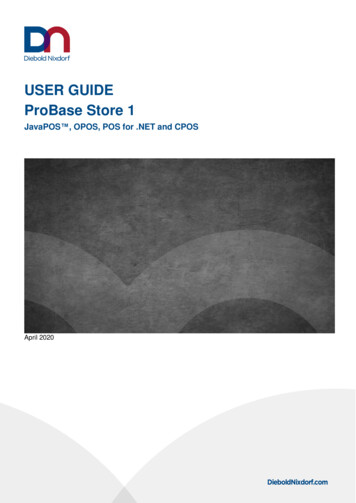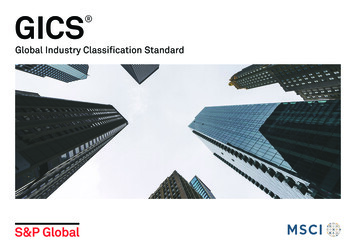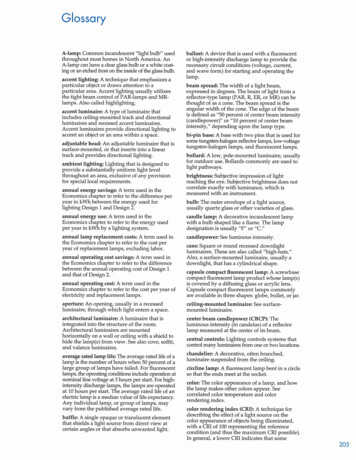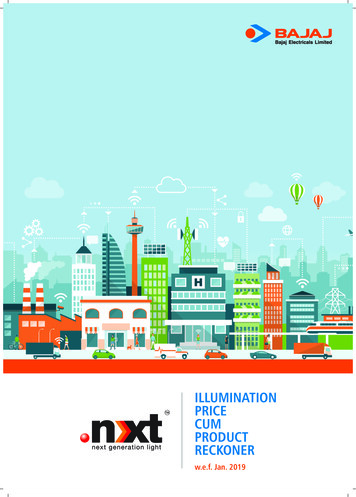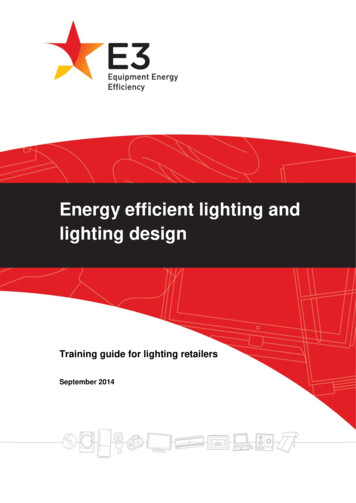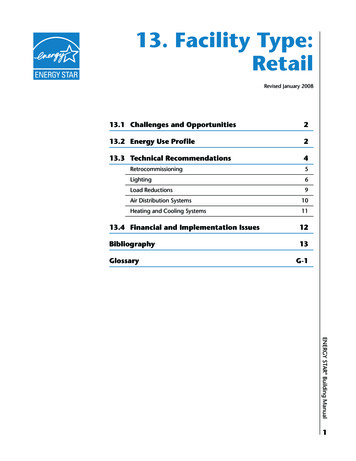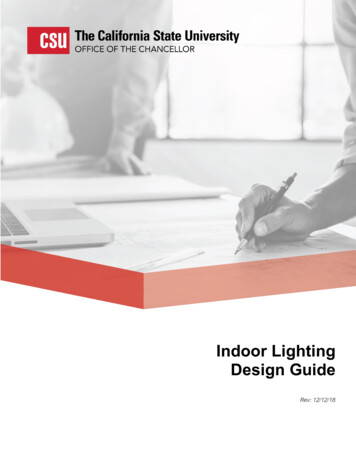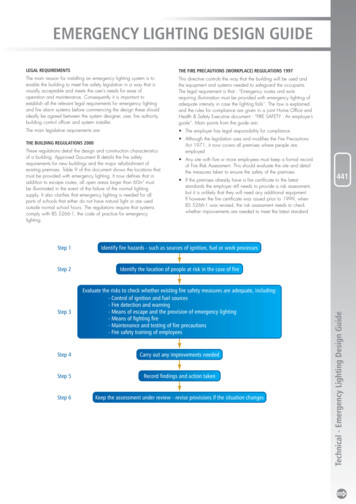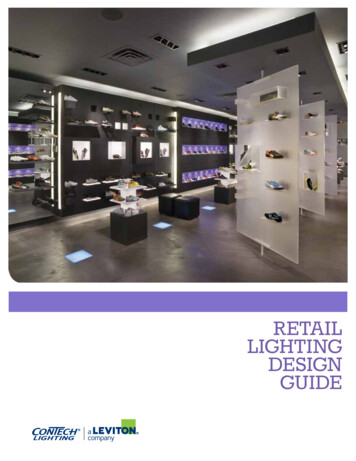
Transcription
RETAILLIGHTINGDESIGNGUIDE
WHAT SETS US APARTINNOVATIONWe combine the latest energy efficient technologyand design styles to create an extensive range ofattractive and sustainable luminaires. We have over5,000 products, including many high performance products that can’t be found anywhereelse. Our EcoTechnology solutions offer sustainable energy solutions that meet the qualitativeneeds of the visual environment with the least impact on the physical environment.SUSTAINABILITYAt ConTech Lighting, our commitment to the environment is as important as ourcommitment to innovation, quality and our customers. We believe that lighting can beenvironmentally responsible and energy efficient, while providing high-quality performanceand outstanding aesthetic design. EcoTechnology applies to our daily operation as well asto our products; from materials, manufacturing and transportation to the disposal processfor our products and by-products.QUALITYWe use the best components and manufacturing methods resulting in the highest qualityfixtures. From cast housings and high performance reflectors, to the testing of eachballasted fixture before it ships, ConTech Lighting is defined by its quality.SERVICEOur responsive, personalized customer focus, and market expertise represents an oasisof outstanding service in an industry that values it, but frequently doesn’t receive it. We arehere for you, live and in person, Monday through Friday 7:30am – 5:30pm CST.PRODUCT AVAILABILITY &SPEEDSHIPTMOur products are in stock and ready to ship. Our uniqueSpeedShip process helps us toward our goal of shipping 100%of placed orders within 48 hours; at no additional cost to you.MARKET EXPERTISEEvery market has its own unique lighting challenges. Designs can get tricky, having toverify every fixture, test every connector and make certain that every length of track is justright. We have an experienced staff of sales professionals to assist you with your projectsfrom concept to completion.Copyright Conservation Technology of Illinois, LLC 20172
Lighting is a critical factor in creating a unique shopping environment: one that attracts customers andpulls them in, creates a store personality while reflecting brand and identity. Successful retail lightingdoes not come in a one-size-fits-all package; it is astrategic blend of color, contrast, control, and energy efficiency. More than application knowledge andexperience, it requires proper application and lighting techniques utilizing the latest lamp and luminairetechnology. A customer that is excited about theirshopping experience will stay longer, spend moremoney, and not only be more likely to return, butenjoy coming back.ConTech Lighting will guide you through the retail lighting process and be your lighting resource.Uniquely qualified to fulfill your retail store lightingneeds, ConTech manufactures a variety of lightingsystems including track, recessed, and decorativethat keep stores fresh and up-to-date. It takes timeand effort to ensure that your investment in lightingwill be returned to the bottom line, and it’s a partnership we’ll be involved with every step of the way.RETAIL LIGHTINGDESIGN GUIDEGoals of Lighting Design5Color, Reflection, and Contrast7Layers of Light11Application Solutions153
4
GOALS OFRETAILLIGHTINGDESIGNThe quantity and quality of illumination, the impression it creates about the merchandise and the effect it has on the retailarea’s appearance are all factors in a successful lighting design. A designer must consider a variety of key characteristicswhen developing their lighting plan including lamp life, system efficiency, lumen maintenance, color rendering and appearance,daylight integration and control, light distribution, points of interest, cost, system control and flexibility. Attract customers; pull them into the store and guide them through, safely and effectively Make an statement: reinforce brand and identity, give an impression about image and price range Create an aesthetically pleasing shopping environment; provide a sense of comfort and well-being for the customer Show off the merchandise: highlight features and displays, enhance colors, textures and forms while avoiding glare Promote merchandise and merchandise evaluation to initiate purchases Enable completion of a sale Reduce energy costsWith the growth and advances in technology, such as smartphones and tablets, the customer journey doesn’t always begin and end in a store; brand, image, and shopping experiencematter more than ever. Lighting helps to convey a specific retail message; it sets client expectations on the quality of merchandise as well as the overall motivation to make a purchase.Choosing the right lighting is critical for projecting the desiredstore image, focusing and attracting customer attention andenhancing the appeal of merchandise, leading to purchase.Lighting solutions vary depending on the target market, storeconcept and brand image; and the best lighting will set youapart from competitors.A well-illuminated store directly contributes to the bottomline. Instead of increasing brightness in shops, and thereforealso energy consumption, use lighting that is high-contrast,makes perception easier, and heightens levels of attention.Diffused general lighting provides a sense of well-being,while vertical illuminance makes orientation easier in a space.Detailed accent lighting improves the perception and attractiveness of the goods displayed. The sales floor is where thebrand comes to life, goods must be shown as true-to-life aspossible using a high CRI light source and a well-balanced mixof light.Products, offers, and displays change frequently in a retailsetting, therefore lighting systems should be highly flexible,enabling a fresh, up-to-date appearance.5
6
COLOR,REFLECTIONandCONTRASTThere are a number of factors to consider when lighting a retail space: the merchandise on display, the size andshape of the space, the intended audience, and the intended message the brand conveys. Many elements come intoplay, such as color, reflection, contrast, and energy efficiency, that make a retail lighting design successful.Retail lighting must have great color; choosing light withthe right color temperature and CRI is crucial. Lighting is akey factor in projecting and supporting store image; not onlyenhancing the look and appeal of merchandise, but affectingthe feeling of the space itself.Two units of measure are used defining light source colorproperties: Correlated Color Temperature and Color Rendering Index.All light sources are not equal. Two white light sources maylook the same, but can render colors differently or provide adifferent feel to the space. By using lamps of the same Correlated Color Temperature and with the same, or very similar,Color Rendering Indices, the space will have even, consistentillumination throughout.Reflection and glare are both useful and potentially harmfulto retail lighting; they can attract the eye to merchandise whenused properly, but irritate and annoy when used incorrectly.Using luminaires with good glare reduction values avoidsdirect glare and disturbing reflections on specular surfaces,such as glossy fixtures, register screens and PIN pads.A very bright store is not the most effective lighting solution. Using contrast to highlight merchandise and different areas of the space, helps customers feel more comfortable anddraws attention to featured merchandise.7
CORRELATED COLOR TEMPERATURECorrelated Color Temperature, or CCT, is a measure of a lamp’s color appearance whenlighted. All lamps are given a color temperature based on the color of the light emitted.White light falls into three general categories: warm, neutral and cool, measured in Kelvin(K). White light with a hint of yellow-like candlelight is called “warm white” (below 3000K);it enhances reds and oranges, dulls blues, and adds a yellow tint to whites and greens.Neutral white (3000K – 3500K) enhances most colors equally, and does not emphasizeeither yellow or blue. Bluish white, like moonlight on snow, is considered “cool white” (above3500K); enhancing blues, dulls reds and imparts a bluish tint to whites and greens.Warm light makes a space feel smaller, more comfortable and familiar, where cooler lightmake areas appear more spacious. Neutral light improves the feeling of well-being, whichmay extend the amount of time the customer spends in the store, leading to a purchase.WARM7000KCLOUDY SKY5500KCLEAR SKY AT NOON4000KCOOL FLUORESCENT2900K2800KCERAMIC METAL HALIDEXENON2500KINCANDESCENT1800KHIGH PRESSURE SODIUM1500KCANDLE LIGHTNEUTRALCOOLCOLOR RENDERING INDEXColor Rendering Index, or CRI, is a measure of how a light source renders colors of objectscompared to how a reference light source renders the same colors. CRI can be used tocompare sources of the same type and CCT.A palette of specific colors is used, and the CRI calculation is the difference between eachcolor sample illuminated by the test light source and the reference source. The group ofsamples is averaged, and a score between 0 and 100 is calculated, with 100 being the bestmatch between light sources.The higher the CRI of a light source, the better – and more natural – colors appear. For products to be presented in a true-to-life way, which increases a store’s credibility, a CRI value of80 – 100 is recommended.Low CRI8High t Grayish RedDark Grayish YellowStrong Yellow GreenModerate Yellowish GreenLight Bluish GreenLight BlueLight VioletLight Reddish PurpleStrong RedStrong YellowStrong GreenStrong BlueLight Yellowish PinkModerate Olive Green
REFLECTIONMATERIALREFLECTANCE PERCENTDiffuse: Uniform surface brightnessLimestoneWhite PaintWhite Structural Glass35-6075-9070-80Spread: General diffuse reflectionBrushed AluminumEtched AluminumProcessed Aluminum (Diffuse)Satin Chrome55-6070-8270-8050-55Specular: Directional control of brightness at specific anglesChromeMetal coated plasticMirrored and optical coated glassPolished aluminumStainless Steel60-6575-9580-9569-7055-65Reflection of light off of the various surfaces within the spaceshould be accounted for in the lighting design. When surfaceswith a higher reflectance are used, light is reflected back intothe space, and higher illuminance levels are created. Light reflectance is based on a scale of 0, total surface light absorption, to 100, total light reflection.Spread reflection materials, such as brushed aluminum, havea high, though diffused, reflection, reflecting 5-10% of light.Diffused reflection materials, as simple as a white painted wall,give a uniform brightness, and are good reflecting backgroundsfor coves and smaller spaces. In addition to reduced energycosts, white and light-reflective surfaces help reduce shadowsfrom racks and stacked goods.CONTRAST RATIOSRetail environments need to make the patrons feel comfortable while highlighting important merchandise and store areas. Simply increasing brightness is not only a waste of electricity, but is also not effective. Bright stores with lots of glaremake customers uncomfortable and less likely to return. Thekey is layering light and using contrast throughout the space.There are four basic layers of retail lighting: General lighting,also called ambient, accent lighting, task lighting, and decorative lighting. Measured in footcandles, the IESNA has illuminance level recommendations based on the type of lighting,the type of space, the type of customer, and how the lightingwill be used (Page 14). By layering these light types, depthand dimension is added to the space.Contrast is achieved by using an increased illumination withinthe different types of light, commonly task and accent, to emphasize featured merchandise against the general light levels.Contrast can be used to create visual hierarchies within theretail environment, enabling attention to be drawn to and focused on certain merchandise based on the contrast ratio. Forexample, a 2:1 contrast ratio, with the accent lighting being twotimes brighter than the general lighting level, creates a barelyrecognizable contrast. Whereas a 30:1 contrast ratio will create a strong focal effect on the focal items.Each type of lighting has many options, and by incorporating therecommended light levels and contrast ratios, the end result is aspace with high visual interest, depth, and dimension.2:1 Ratio30:1 RatioOPTICAL PERFORMANCEBrain DecoderLight SourceEye ReceptorPerformance requirements for lamps and integrated luminaires:1. Visual appearance of light on a surface2. Numerical performance, light level, and efficiency3. Visual appearance and glare control of the luminaire itselfObject9
10
LAYERSOFLIGHTThere are four layers of light typically used in retail lighting: general (also called ambient) lighting, task lighting, accent lighting, anddecorative lighting. Combining and balancing these lighting types gives visual interest to the space and creates a more attractive,exiting and inviting environment.GENERAL LIGHTINGGeneral lighting is the main source of illumination in aspace. This uniform, base level of lighting can easily becomethe focus of energy reduction, as the light levels from otherfixtures can be lowered, especially when using LED sources.Recommended light levels for general lighting is 30 - 50footcandles. With minimal illumination of the merchandise,general lighting allows the staff to perform daily tasks suchas cleaning and re-stocking, as well as customer circulationthroughout the space. Diffused general lighting ensures asense of well-being, which makes customers feel comfortable and more likely to stay longer in the store. A simpleway to achieve this is by arranging recessed fixtures usingreflectors, baffles, and lensed trims in overlapping positions.Perimeter lighting, or wall washing, helps define merchandising spaces, provides vertical lighting and makes the retailspace feel larger. Done with sconces or wall washers, verticallighting creates a pleasant, welcoming environment and addsto the visibility and visual impact of the displays on the walls.It is important that vertical surfaces are lit for visual comfort,spaciousness and visual and directional cues. Vertical brightness influences the customers’ impression of the store bymaking orientation easier, helping to define merchandisingspaces, and aiding in making the space’s appearance to belarger, open and more welcoming for the consumer.TASK LIGHTINGTask lighting is used to illuminate an area for a specific task;providing a focused, localized, and higher level of illumination.Necessary to the functioning of a space, it is important to useenergy efficient sources to reduce operating costs.Task lighting is most effective when used as a supplement togeneral lighting in workspaces, conference areas and on counter tops. Effective task lighting should eliminate shadows on thespecific illuminated area, while preventing glare from the lampor off surfaces.Completing the sale is the most important retail task; it isthe final interaction between the customer and staff. Pendantluminaries at the point of sale are a great way to provide tasklight for sales work; enabling staff to quickly and accuratelywrap packages, run register sales and credit card transactions, minimizing mistakes and returns. Recommended lightlevels for task areas are 50 – 200 footcandles. When lightinga task area, take into account the difference in brightness, orcontrast, between the task area and the surrounding space. A3:1 ratio of task lighting to general illumination provides a nicecontrast for evaluating merchandise, reading tags, labels, orpackaging and reading signs that identify store departments.The amount of light needed on the task, or luminance, is usually the most flexible variable of task lighting, and can be increased to compensate for low contrast levels.11
ACCENT LIGHTINGAccent lighting creates a dramatic emphasis on merchandiseusing a focused, or point, light source or sources. It addsdepth, contrast and creates a focal point for merchandise tobe displayed; it highlights shape, texture, finish and color ofmerchandise, drawing customers to it. If this light is directedambiguously, the end result may have many unwanted shadows obstructing the details of the highlighted merchandise aswell as distracting glare.The key is to make this illumination more precise and of higher intensity than the surrounding ambient light. Track fixtures,recessed housings with adjustable trims and concealed adjustable illumination with point source lamps provide directional control and are especially effective for accent lighting.They are easy to aim precisely to highlight products’ bestattributes and influence the customers’ impression. Accenting everything and emphasizing nothing is a common mistakewith accent lighting; always keep in mind that there such athing as providing too much light.The IESNA recommends a 5:1 ratio of accent lighting to ambient light to make merchandise stand out and create a significant visual effect; dark merchandise may require a higherratio to bring out detail. Recommended light levels for accentlighting are between 150 – 500 footcandles. For feature displays, higher ratios of 15:1 or 30:1 are used, especially tocreate sparkle in jewelry or crystal.DECORATIVE LIGHTINGDecorative lighting serves a dual purpose: not only to contribute to the lighting layers in a retail environment, but also toenhance the look of the space as a design element. Decorativelighting includes pendants, sconces, chandeliers, table andfloor lamps, and cylinders. Decorative lighting should complement and add visual interest to the interior, as well as provideor contribute to the overall lighting plan.Pendants should be mounted 8 - 12 feet above the finishedfloor (a.f.f.) so they are still within view, but not too low as todeter the shopping experience. Pendants displayed over counters should be hung 36 - 48 inches above the horizontal planeso customers can peer into the glass without being hinderedby the luminaire.12Wall sconces and wall mounted cylinders should be mountedapproximately 5-1/2 feet a.f.f.; this helps to create a sense ofhuman scale, especially in a large space.Adding décor, beauty and style using decorative lighting is alsoan important reflection of a store’s brand image, and reinforcesthe theme and style of the space. Decorative lighting can alsocontribute a feeling of hospitality and comfort to the retail experience, putting shoppers at ease and encouraging a longervisit, which can potentially lead to more sales.By combining and layering these lighting types, your storeenvironment will be more attractive, exciting, and inviting.
13
14
APPLICATIONSOLUTIONSThere are many factors to achieving great retail lighting design; the end goal is to increase sales. Using lighting intelligentlyto enhance merchandise and create a feeling of well-being for the customer increases the propensity to make a purchase. AtConTech, our goal is to create a balance between lighting effect, affordability and adaptability. We offer a wide range of fixtureoptions to optimize the appearance of merchandise, while minimizing ongoing operating cost.WINDOW LIGHTINGEvery retailer is competing for the customer’s attention; theretail window is an opportunity to stand out. It should be apowerful attraction, providing a link between the passersby andthe merchandise within the store. Attract customers with drama; engage the passerby with intense white light using uniformsaturated illumination, direct accent lighting to highlight and todefine the merchandise, create stopping power that will makeconsumers want to come inside and invest themselves in thesales experience.An energy-efficient lighting solution often overlooked in retailspaces is daylight, which adds another dimension to the overalllighting design. Understanding how the natural light interactswith the space can improve the visual appeal of merchandise.The window lighting should change depending on the time ofday. During daylight hours, strong accent lighting focused ondisplayed merchandise will attract more attention. At night, using a low ambient lighting level, in addition to the strong accentlighting, will peak viewer’s interest.The entrance requires a high brightness to compete with thesurrounding light, and under canopy lighting needs added degrees of protection. The brightness must be distinctly clearfrom the outside and from greater distances, as there will be nosecond chance at creating that first impression. The quality ofthe entrance dictates your potential customers further action,whether to enter or not.15
SHELF, CASE & COUNTER LIGHTINGThe most common way to light these spaces is to use smallsources – such as LED tapelight – close to the display objects,but hidden from view. It is imperative to showcase productscreatively to boost their appeal. Illuminance levels should be3-5 times higher than the surrounding ambient light, highlighting merchandise for easy evaluation by the customer.The light source color temperature and CRI must be chosencarefully as to not distort, damage or alter the look of the merchandise being displayed. The way that the light is directed ontoshelves is crucial: backlighting shelves can produce a more attractive effect than only using accent lighting to highlight themerchandise. Lower level shelves go relatively unnoticed, but bytargeting accent lighting and/or backlighting on the lower thirdof shelves, customers linger longer, encouraging sales.RACK LIGHTINGRack lighting attracts customers to, and allows easy evaluationof, merchandise. The lighting system should accomplish twothings: fully illuminate the merchandise and accurately displaycolor and texture. With constant changing display needs, it isimportant to keep this system flexible. ConTech track light-16ing systems are ideal, as fixtures can be added, removed ormoved without having to shut power to the track. Illuminancelevels on merchandise should be at least three to five timeshigher than the ambient surrounding levels.
FITTING ROOM LIGHTINGQuality dressing room lighting is imperative because this iswhere the majority of buying decisions are made. High quality light with a high color rendering index should be used toprovide form and texture to merchandise and make colorsappear natural and realistic; the color of the merchandiseshould render the same in the fitting room as it did on thesales floor. Using lamp sources with similar CRIs and CCTs willmake things look consistent between the two spaces.Most fitting rooms are illuminated by overhead fluorescentluminaires. Instead, combine diffused and directional lightsources with a good CRI to provide flattering light. This willmake both the customer and your merchandise look theirbest. Proper fixture placement is essential for elimination ofshadows, especially when viewing images in mirrors. The customer, not the mirror should be illuminated.Using energy saving lighting technologies in fitting rooms hasan added benefit: they radiate less heat. This reduces thecooling load and helps to make dressing rooms more comfortable, as well as lowering overall energy costs.EXIT & EMERGENCY LIGHTINGConTech offers a variety of high quality exit and emergency lighting fixtures to suit your space. When general lightingsystems fail, exit and emergency lighting direct the safe exitof the building’s occupants. If no exit is required, the lightingshould provide security and comfort until the general lightingcan be restored. ConTech’s exit and emergency fixtures aretested to the highest safety standards; meeting or exceedingNFPA101, NEC and UL294.17
18
IESNA1ILLUMINANCESAreas/TasksDescriptionType ofActivity Area*CirculationArea not used for display or appraisal of merchandiseor for sales transactionsHigh ActivityMedium ActivityLow Activity302010Merchandise(Including Showcasesand Wall Displays)High ActivityMedium ActivityLow Activity1007530High ActivityMedium ActivityLow Activity500300150That plane area, horizontal to vertical,where merchandise is displayed and readilyaccessible for customer examinationFeature Displays3Single item or items requiring special highlighting tovisually attract and set apart from the surroundShow WindowsDaytime LightingGeneralFeatureNighttime LightingGeneralFeatureIlluminance (FC)22001000100-200500-1000*One store may encompass all three types within the buildings.High Activity: Merchandise is usually displayed in bulk and is readily recognizable as to its use. Evaluation and viewing time isshort. Minimal sales assistance and few customer amenities are available. Included in this category are mass merchandisers, warehouse sales, grocery and discount stores, auto parts departments, and hardware departments.Medium Activity: Merchandise is familiar, but the customer may require time or help in evaluation of quality or usage or in thedecision to buy. Some sales assistance and customer amenities are available. Included in this category aredepartment and specialty stores.Low Activity: Merchandise is generally exclusive, of the finest quality and highest price. Personal services and premium customeramenities are expected. Shopping is generally unhurried. Included in this category are fashion boutiques, designersignature shops, jewelry stores, fur salons, and fine art galleries.1. IESNA Lighting Handbook, 8th Edition2. Maintained on the task or in the area at any time.3. Lighting levels to be measured in the plane of the merchandise.19
esi D gned aSAes D igned aSAted in thePrinUndesi D gned aesi D gned aSAted in thePrinUndted in thePrinUndDesigned and Printedin the USALITRET17es D igned aSAted in thePrinUndSAesi D gned aDesignedand Printedin the USAted in thePrinUndesi D gned aSAted in thePrinUndAll specifications subject to change without notice.Designedand Printedin the USAesi D gned a725 Landwehr RoadNorthbrook, Illinois 60062www.contechlighting.comted in thePrinUndSASAted in thePrinUndDesigned and Printedin the USA
DESIGN GUIDE Goals of Lighting Design 5 Color, Reflection, and Contrast 7 . rative lighting. Measured in footcandles, the IESNA has illumi-nance level recommendations based on the type of lighting, the type of space, the type of customer, and how the lighting wil


